Known as the hen of the woods, maitake, sheepshead mushroom and signorina these delicious, bountiful fungi have lots of names and are king of the Fall mushrooms in the Midwest. In this post I'll tell you everything you need to know to find, identify, harvest, clean and cook them.
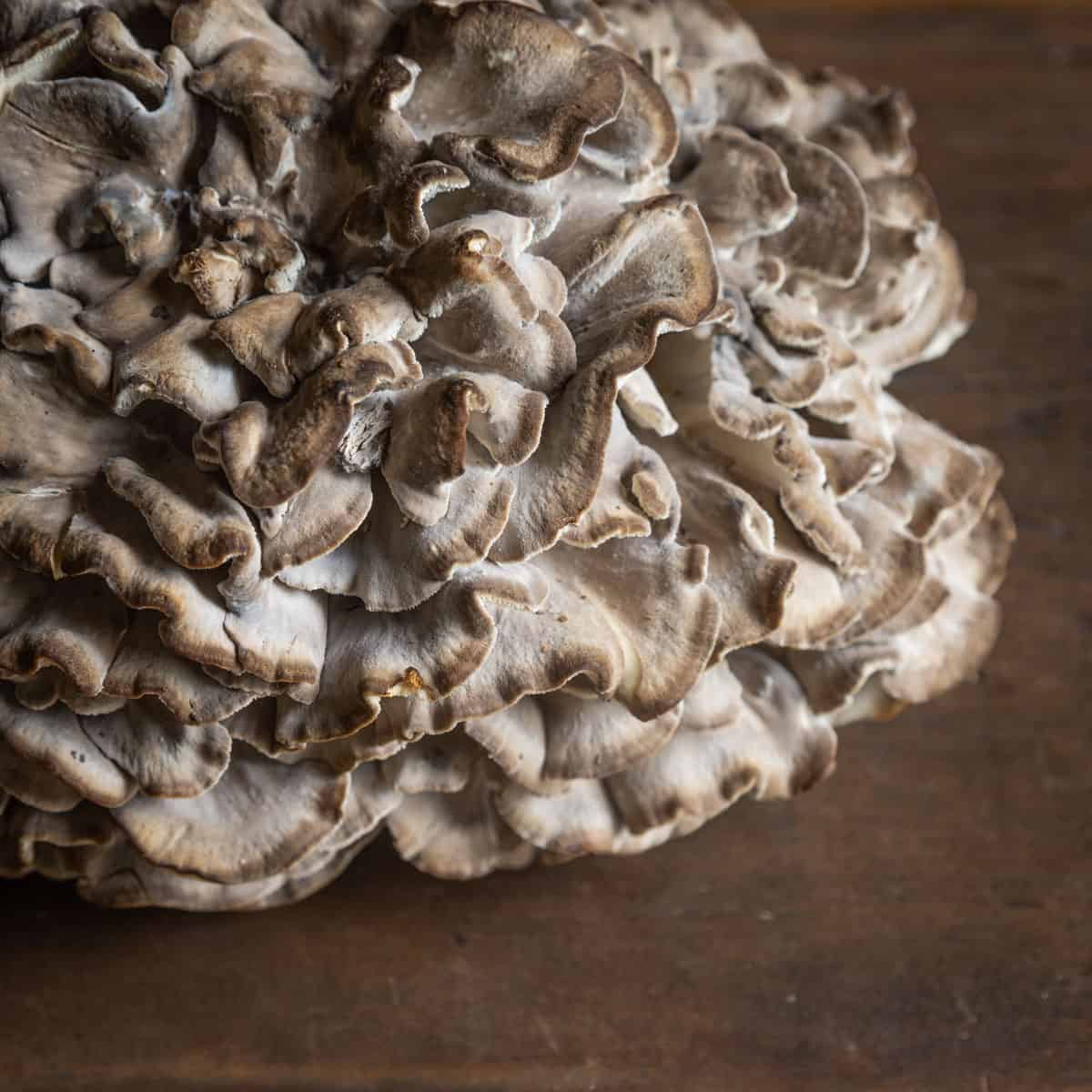
One of a few mushrooms only found East of the Rockies in North America, hen of the woods, (also known as Grifola frondosa) are a choice edible mushroom that grows at the base of trees. At a glance the mushrooms look like a roosting bird, which is where the name comes from. They're a parasitic polypore mushroom that infects living trees and injured trees, causing a butt-rot in the host.
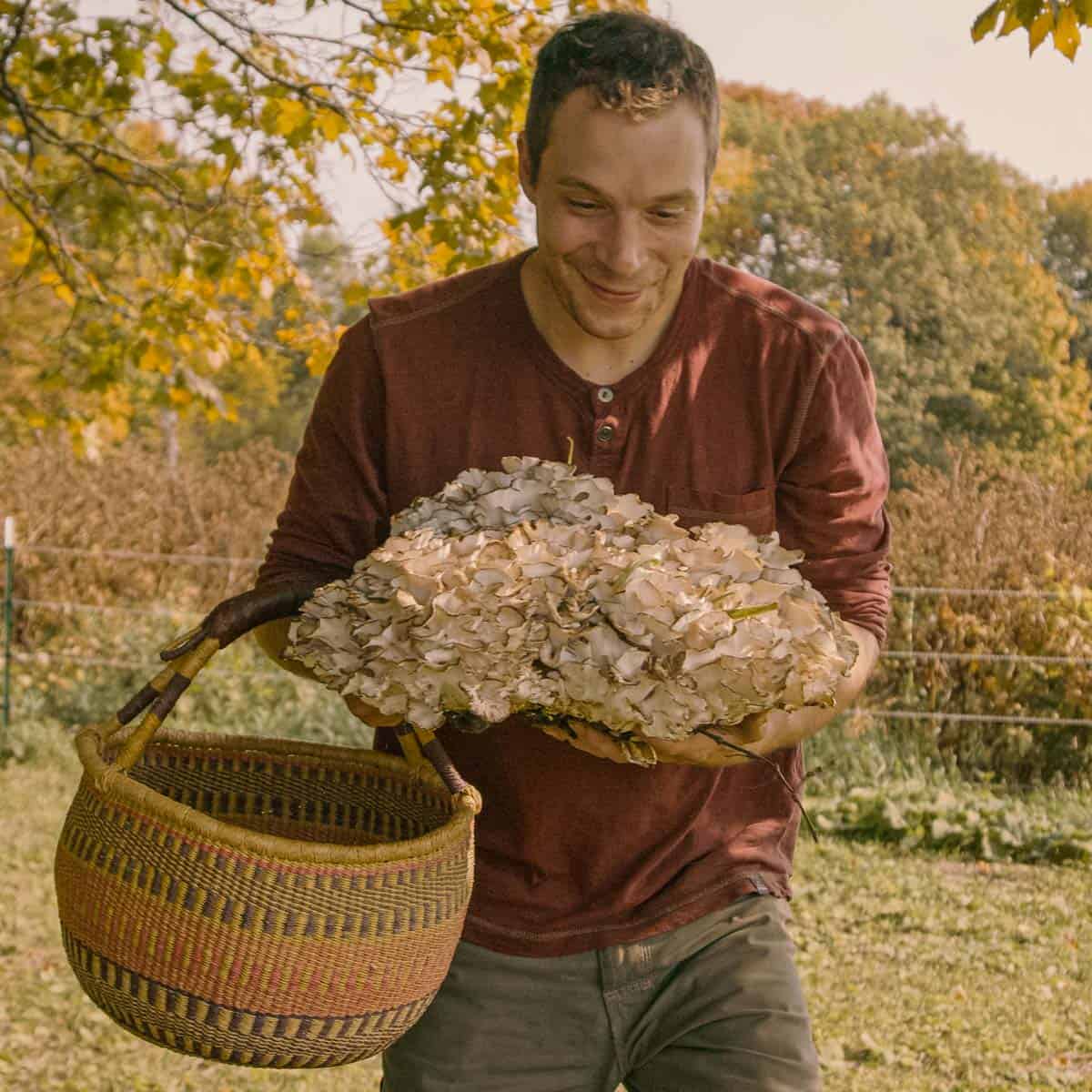
Also known as maitake (dancing mushroom in Japanese) these have a long history of use in Japanese cuisine and culture. As legend has it, perfect mushrooms could be worth their weight in silver and harvested by samurai or given as gifts to the shogun. They're also prized in Japan for their (reputed) medicinal properties supporting the immune system.
How to Identify Hen of the Woods
One of the easiest, and safest wild mushrooms to identify for beginners, hens are easy to spot, even at a distance. Here's a few tips on properly identifying hen of the woods.
- Appears as a cluster at the base of trees, especially oak.
- Caps can be light to dark grey, smoky brown, or a combination.
- Are composed of rosettes of layered caps originating from a central stem.
- Instead of gills, the reproductive structure is white pores on the underside of the caps.
- Will grow on dead, dying, or downed trees, as well as stumps.
- Will occasionally grow directly from the roots of fallen trees and logs.
- They have a distinct fan-like shape, and the cap is layered with frilled edges or ruffles.
- Have a white spore print often visible on mature mushrooms.
- Bruise brown when handled over time.
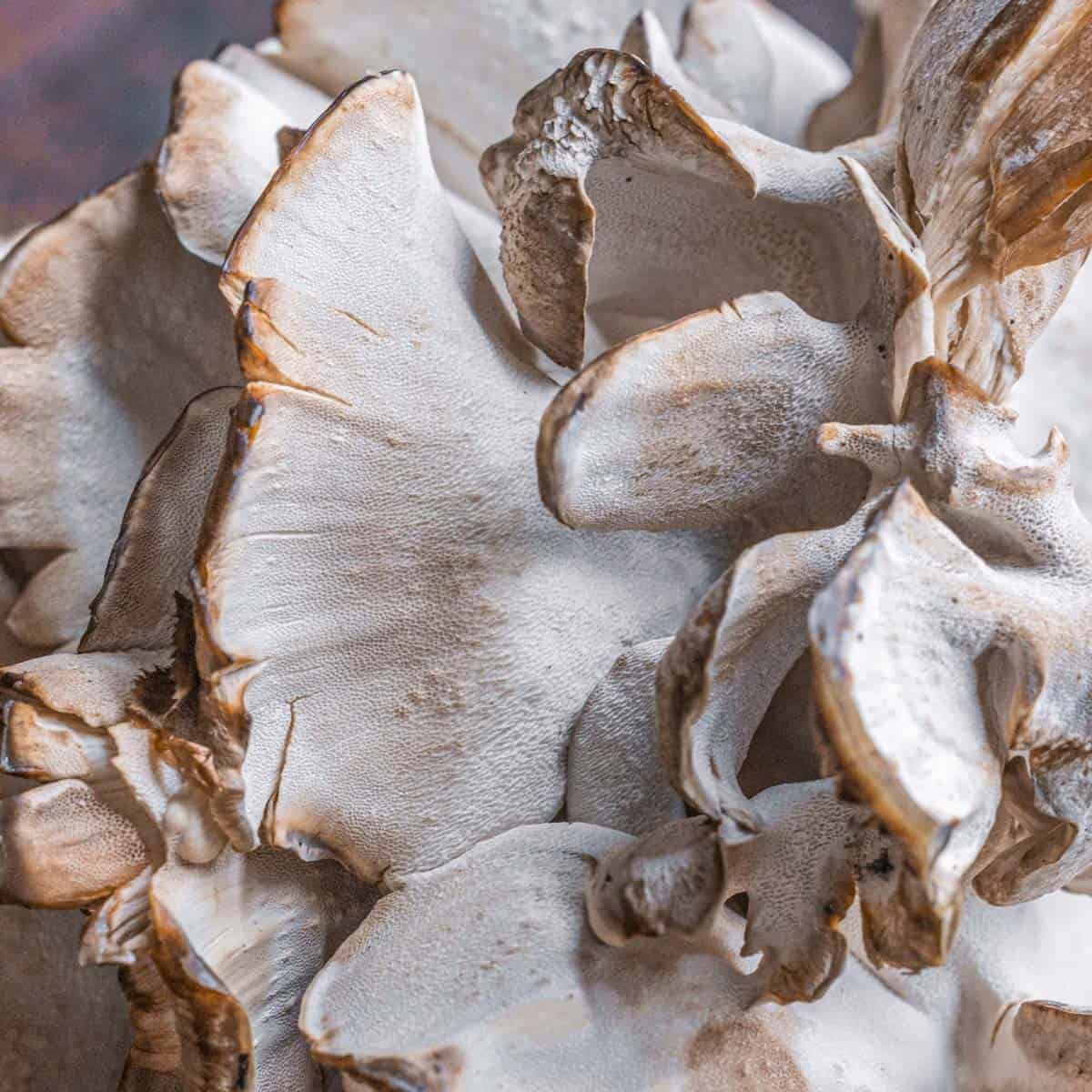
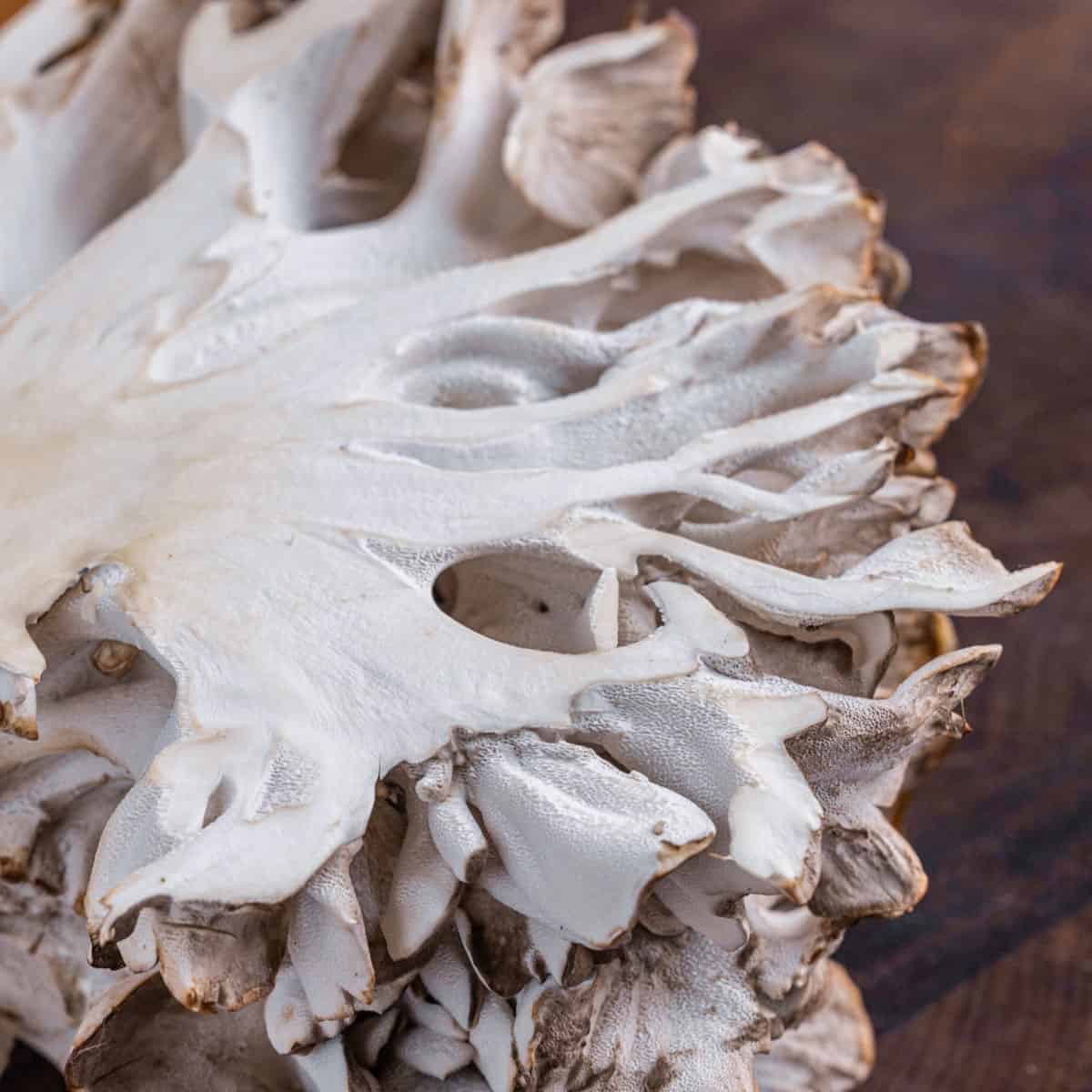
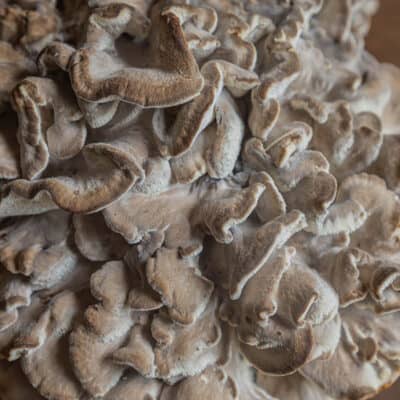
Where to Find Hen of the Woods
Where I hunt in Minnesota and Wisconsin, the easiest way to look for large, old oak trees. Red oaks seeming to be their preferred host.
Hens appear in late Summer around September and continue through the fall (October) but you might see an occasional one in August. These can grow to be massive, and I've picked clusters that have weighed thirty pounds.
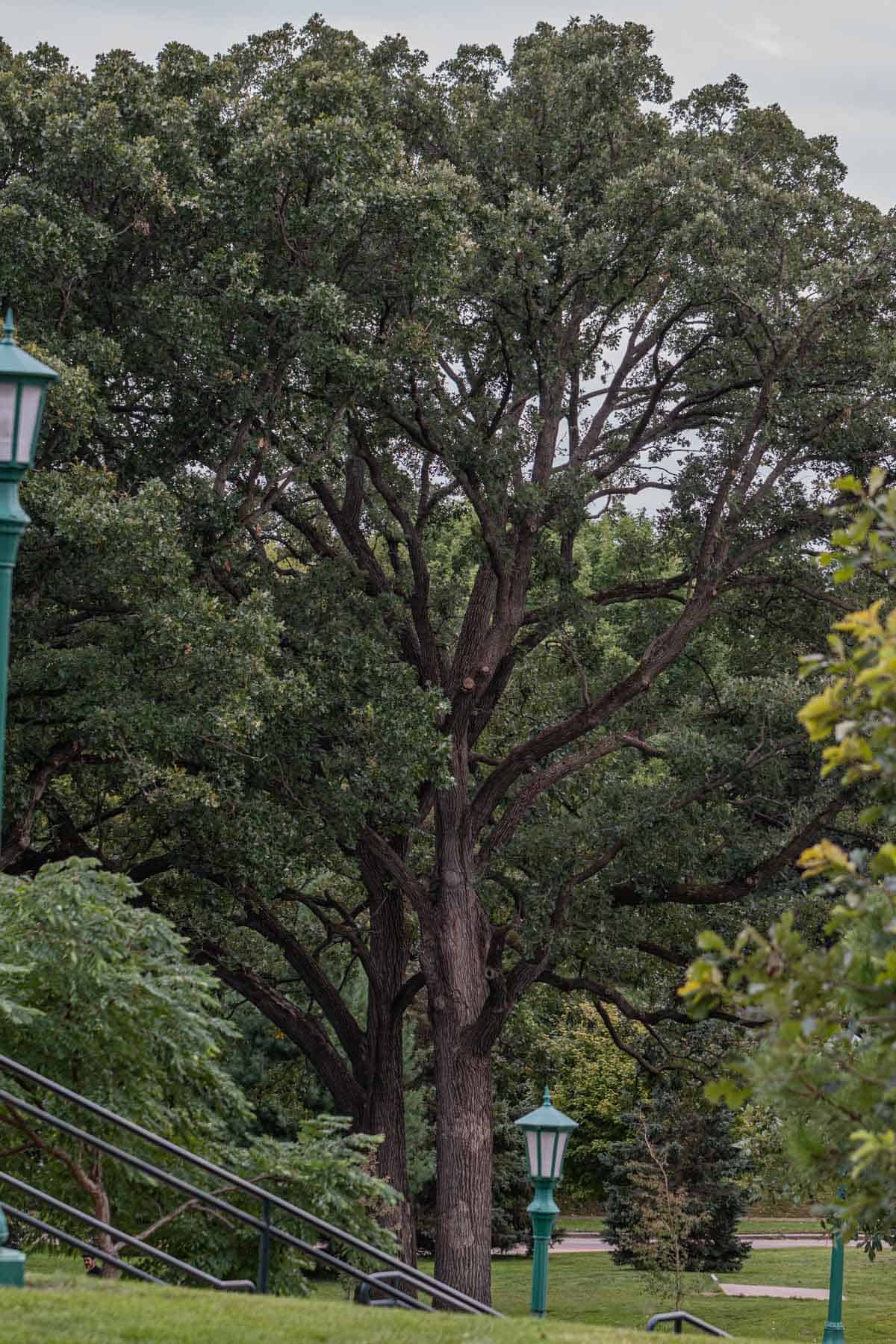
You don't need to be in the deep woods for these. Here's the best tips I have:
- The bigger the tree, the bigger the mushroom can be. Look to your nearest local park that has big old oak trees.
- If you're in an open, grassy area make sure the grass isn't being sprayed with chemicals, as happens on golf courses.
- Hen of the woods grow at the base of white oak trees, red oak trees, and rarely on maple trees.
- Hunting on bike helps you cover area quickly to find hens along paved trails.
- If there's one there's more. If one tree has a hen, then the whole grove has been infected. Look around the base of other trees in the area.
- Look for death and decay in woods that have lots of fallen trees and oak stumps.
- Hens are a semi-common yard mushroom. Hunt by car in your neighborhood and ask politely to pick if you find one.
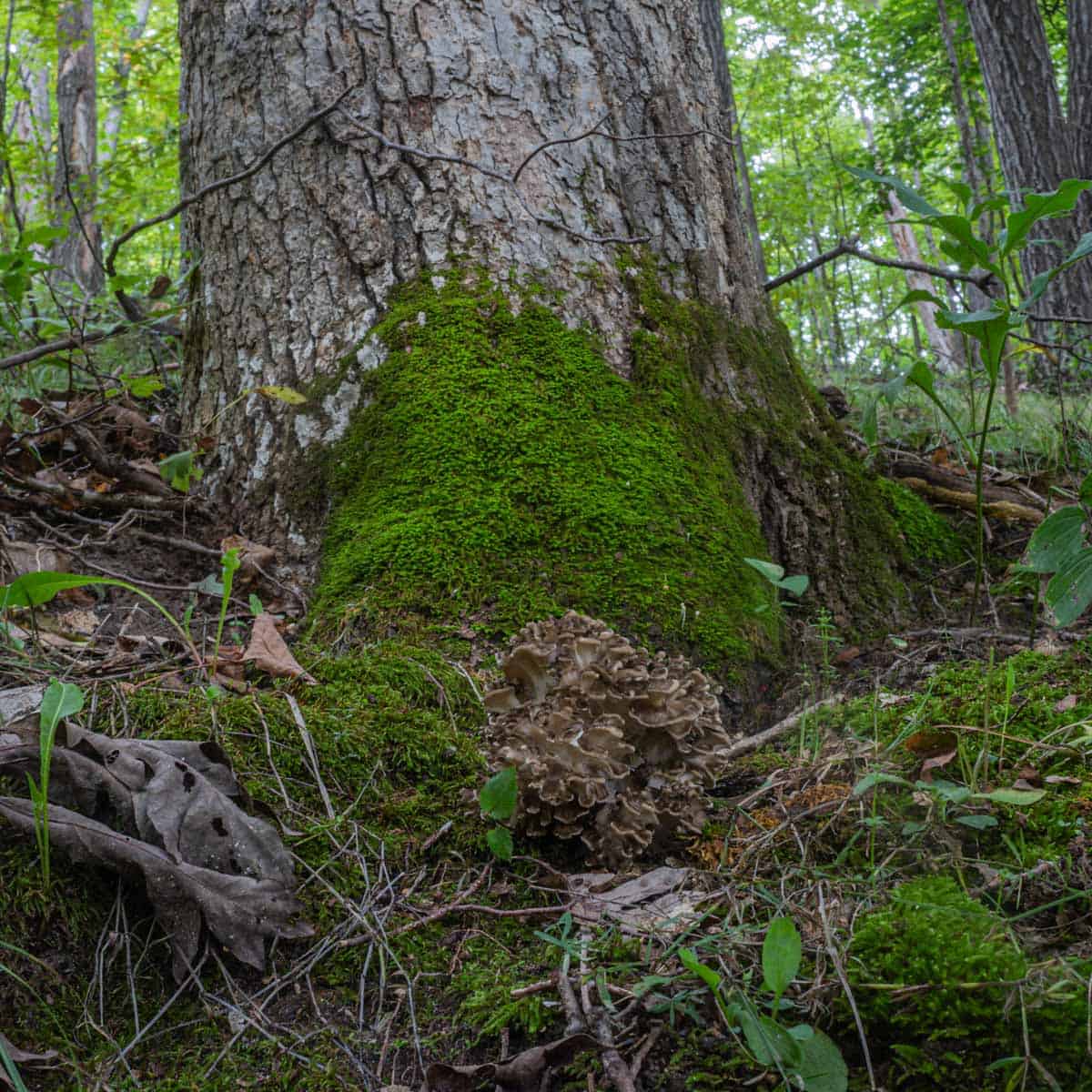
The mushrooms will come back year after year in the same location. When you find an infected grove, go there regularly once the mushrooms start to fruit. Different trees will give hens at different times throughout the season.
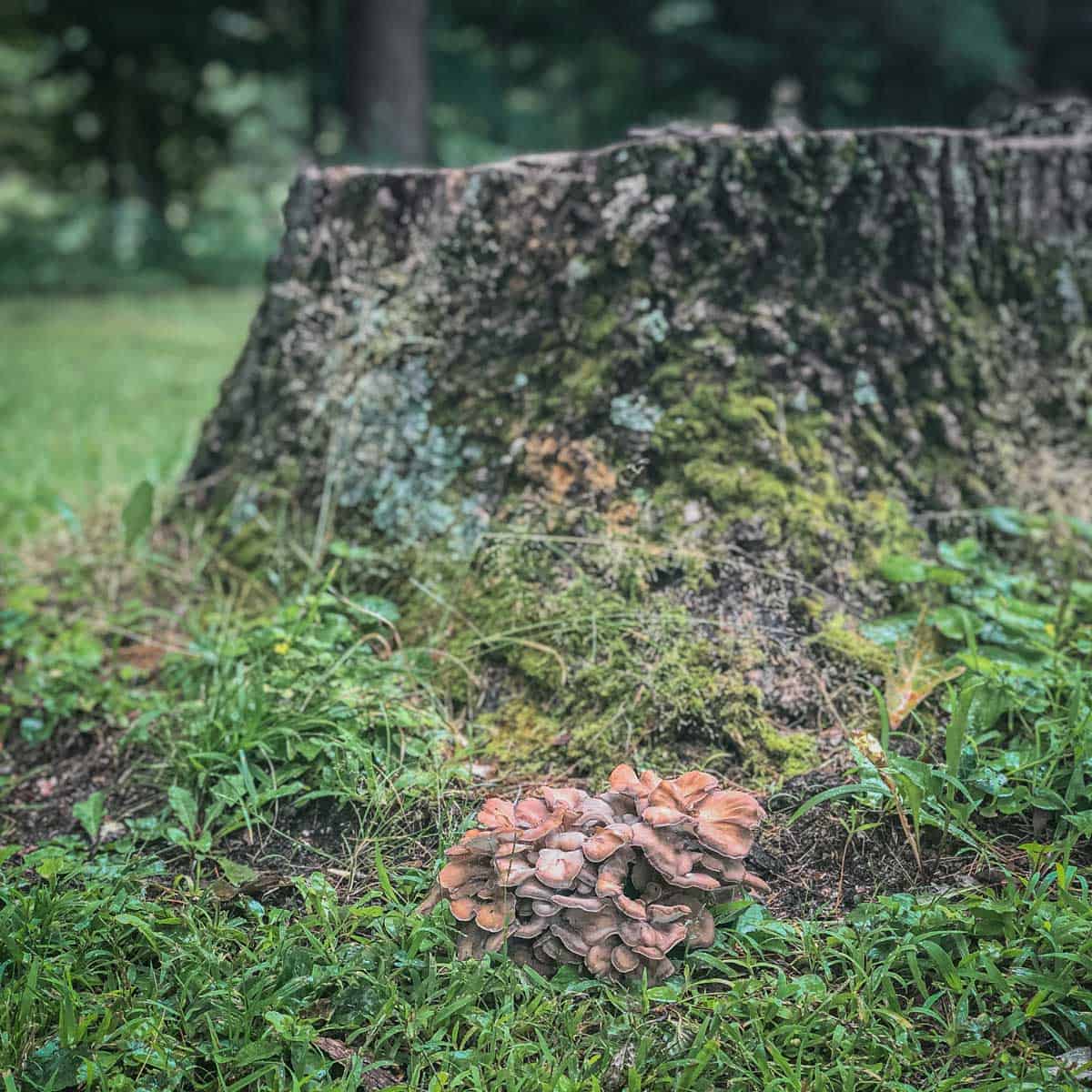
Hen of the Woods Look Alikes
There's a few mushrooms that look like hen of the woods, or could be confused with them, but here are no poisonous look alikes. Here's the top five you should know.
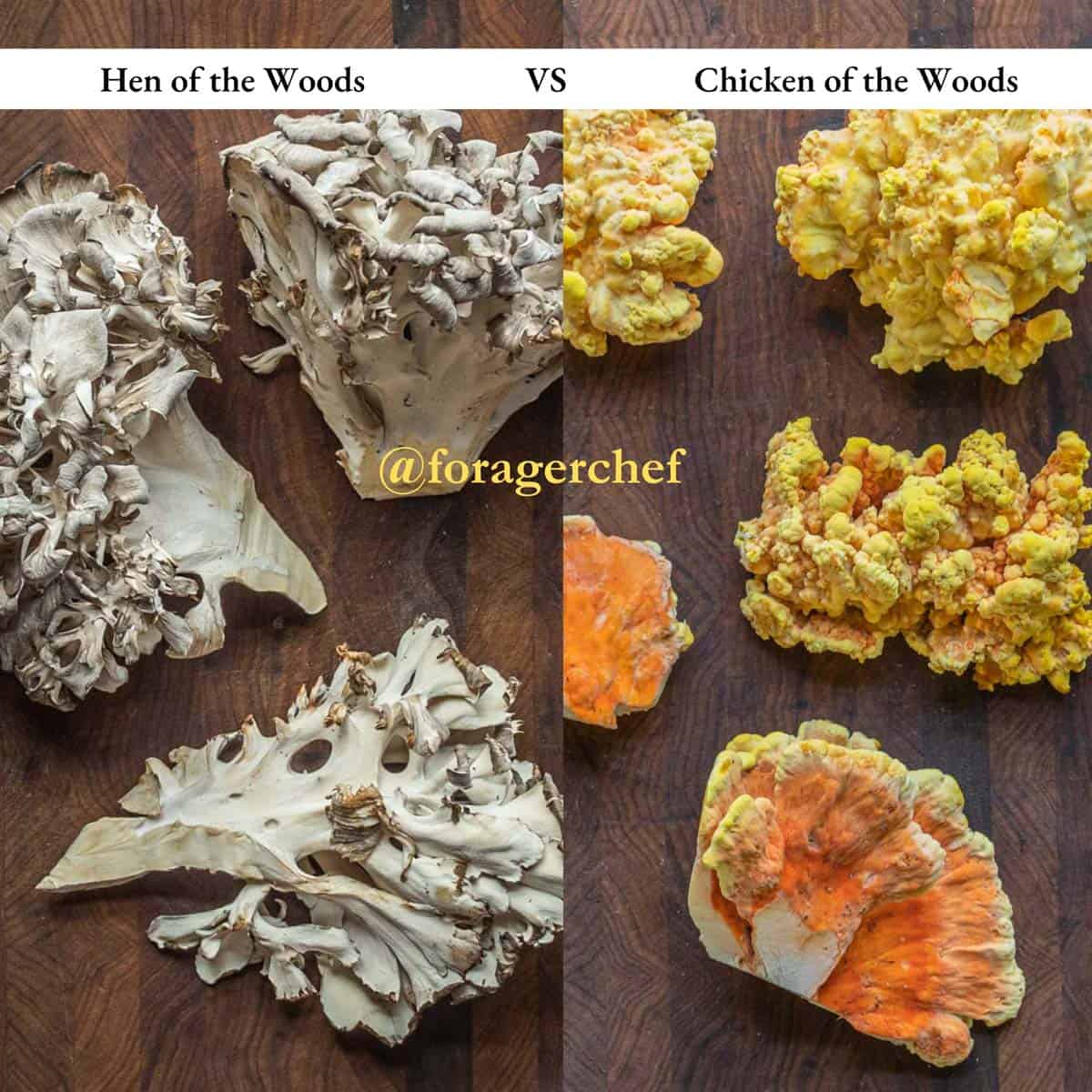
Umbrella Polypore / Polyporus umbellatus
The umbrella polypore (Polyporus umbellatus, formerly Grifola umbellata) is very good, but rare. It grows in the summer at the same time as hen of the woods, and can also be found on oak trees. It's easy to tell the difference from a true maitake as the caps of P. umbellatus have a funnel shape.
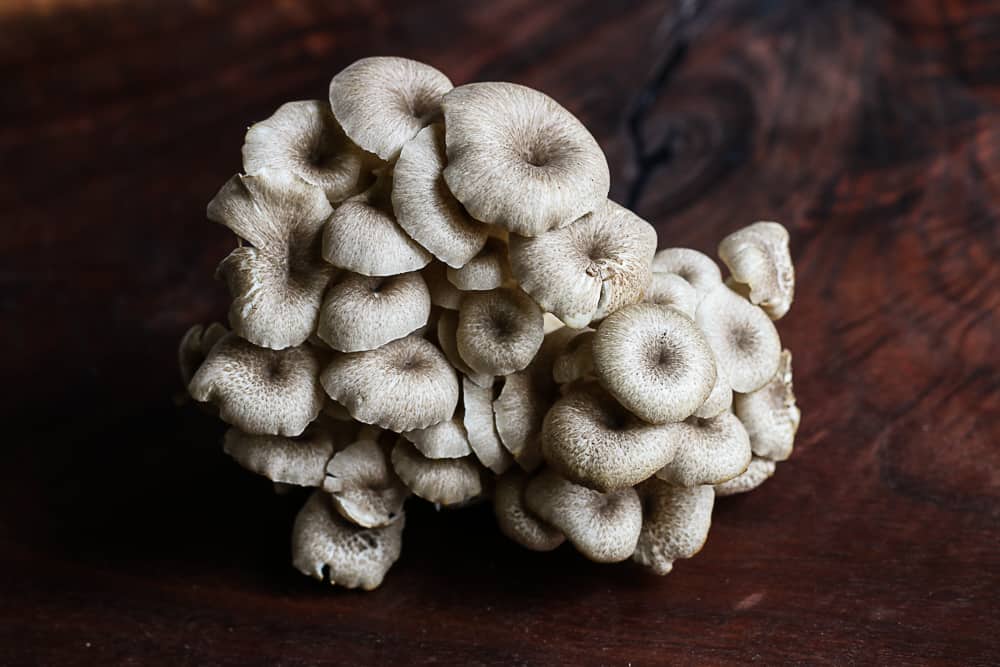
Black Staining Polypore (Meripilus sumstinei)
Also easily confused with hens, the black staining polypore also grows at the base of infected oak trees, but is easily identified from its black staining when bruised or handled. It's delicious, tasting like a hen crossed with black trumpet mushrooms.
It's tougher than hens, and need special treatment like drying and powdering. Cut the tender ½ inch margin into duxelles, or make them into stock and broth.
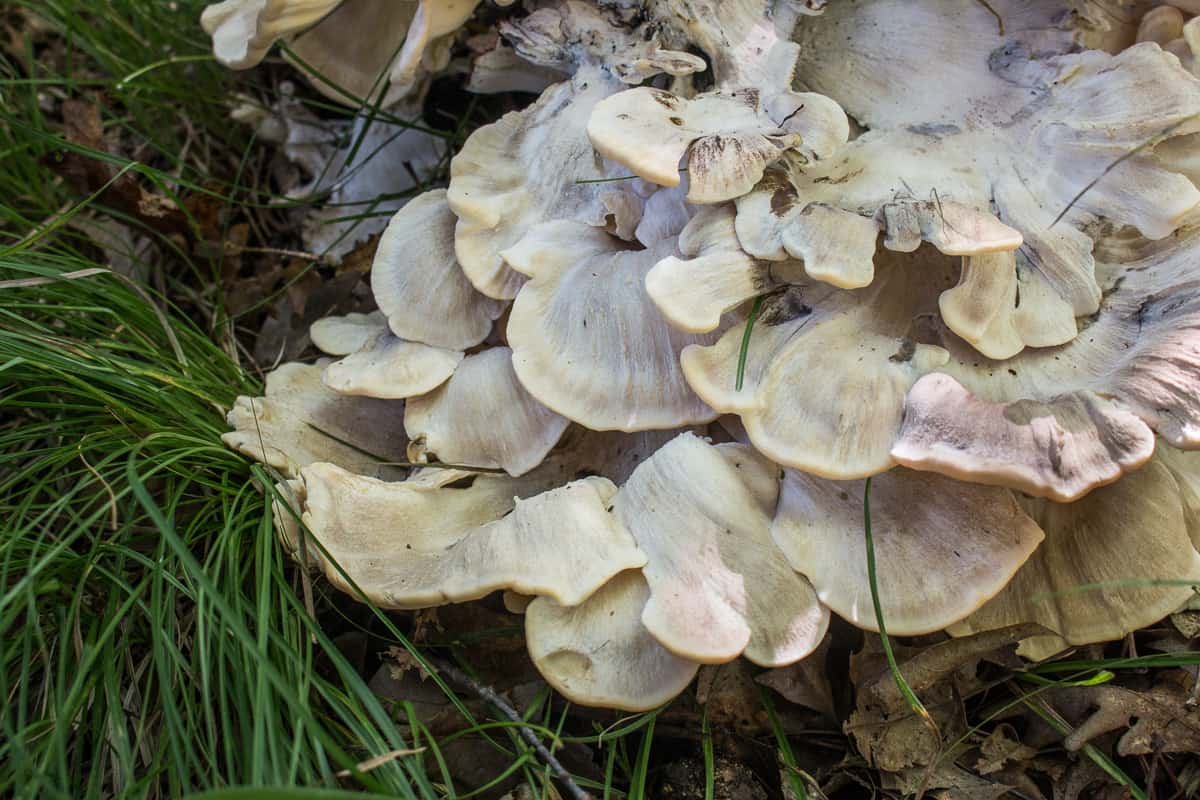
Berkley's Polypore (Meripilus giganteus)
A large cousin of the BSP, Berkley's polypore infects beech, pine, spruce and firs as well as oaks. Like other meripilus, it's very tough when mature, and only the tender outer edge should be used. I think they're best used to make duxelles or mushroom stock.
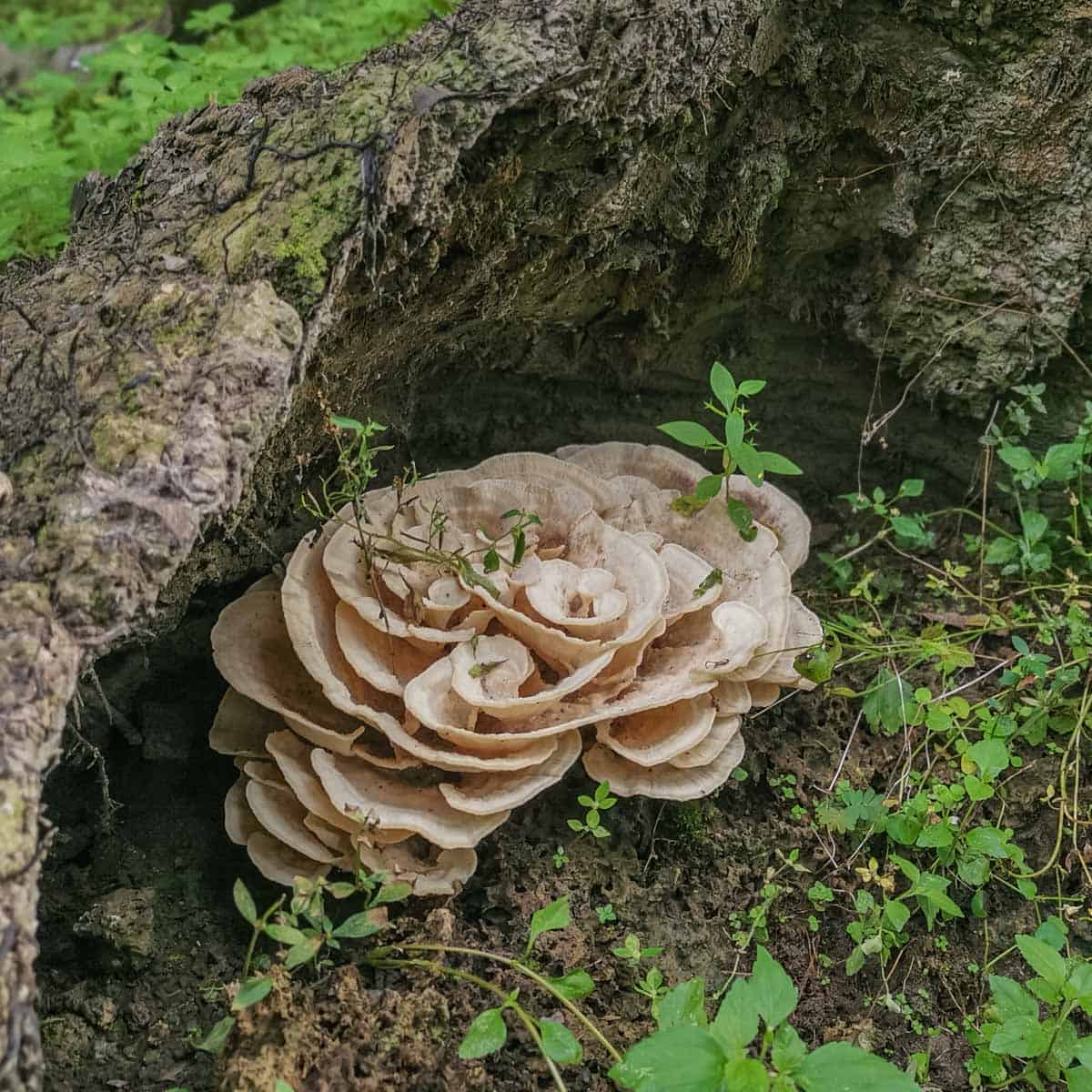
Bonderzewia
Another parasitic fungus that grows at the base of oak trees. These are a rare find for me but are definitely a mushroom that looks like hen of the woods. They seem far too tough to be useful, but many people still say that about black staining polypores. They're not harmful to my knowledge, but they would be very hard to chew.
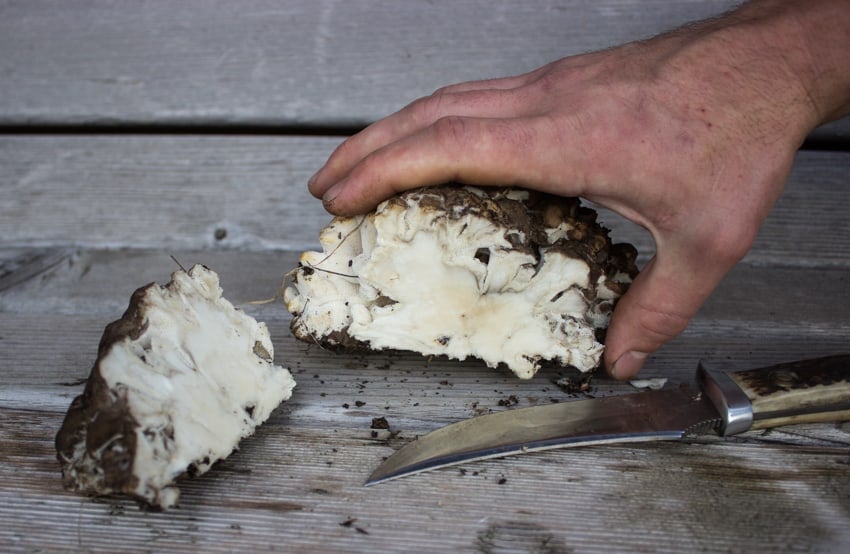
How to Harvest Hen of the Woods
The first thing to do is inspect the mushroom. If you can see white spores on the ground it's past-prime, but could still be ok to eat. Older mushrooms will be tougher, younger ones are more tender. Grasp the base of the mushroom and pull it up, then carefully trim any dirt from the stem.
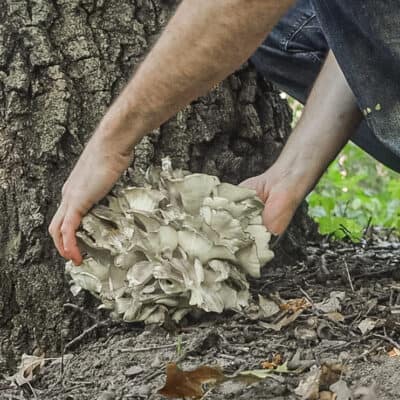
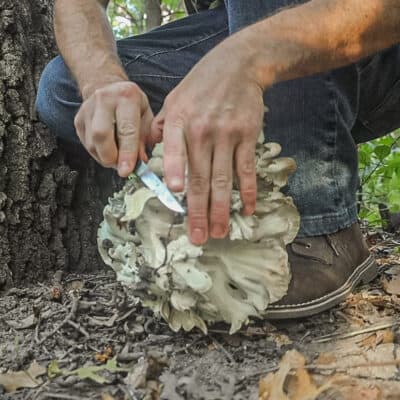
Inspect the mushroom closely for dirt, leaves and debris. If it rained recently you may want to pass. The best mushrooms should feel tender, and look very clean without grit stuck in or on the fronds.
Knowing when to harvest hen of the woods is important. Bigger is not necessarily better and waiting to see how long it takes a hen of the woods to grow can ruin your mushroom. Most of the time when I find a hen I take it unless it's just starting.
Older mushrooms that can be tough and buggy will usually have visible white spores around them-a sign you might want to keep looking for a better mushrooms. Hen of the woods grow moderately fast, so go back in 3-4 days if they're too small to harvest.
Below, left to right: older mushrooms will be tough, younger mushrooms are very tender, and perfect mushrooms are in the middle.
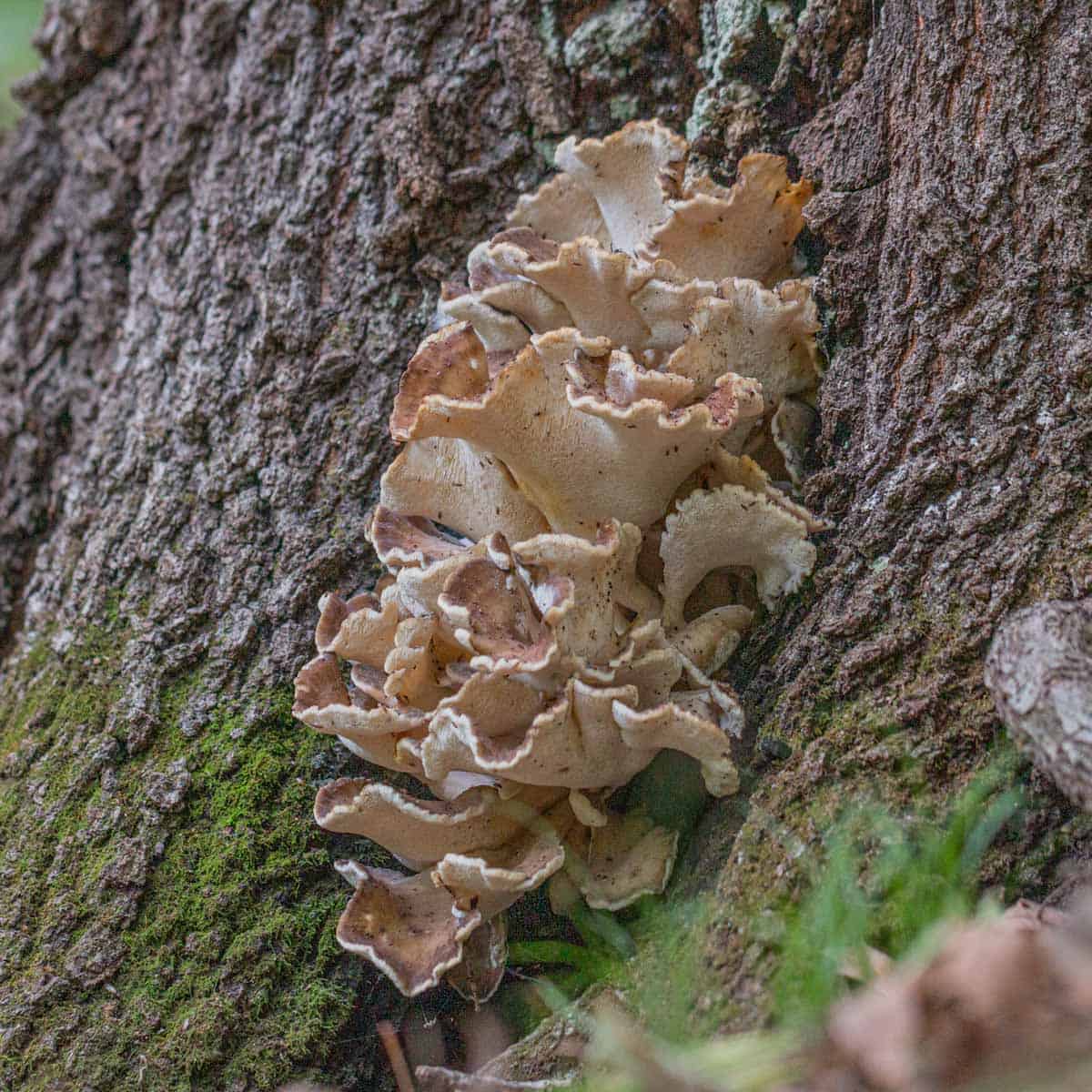
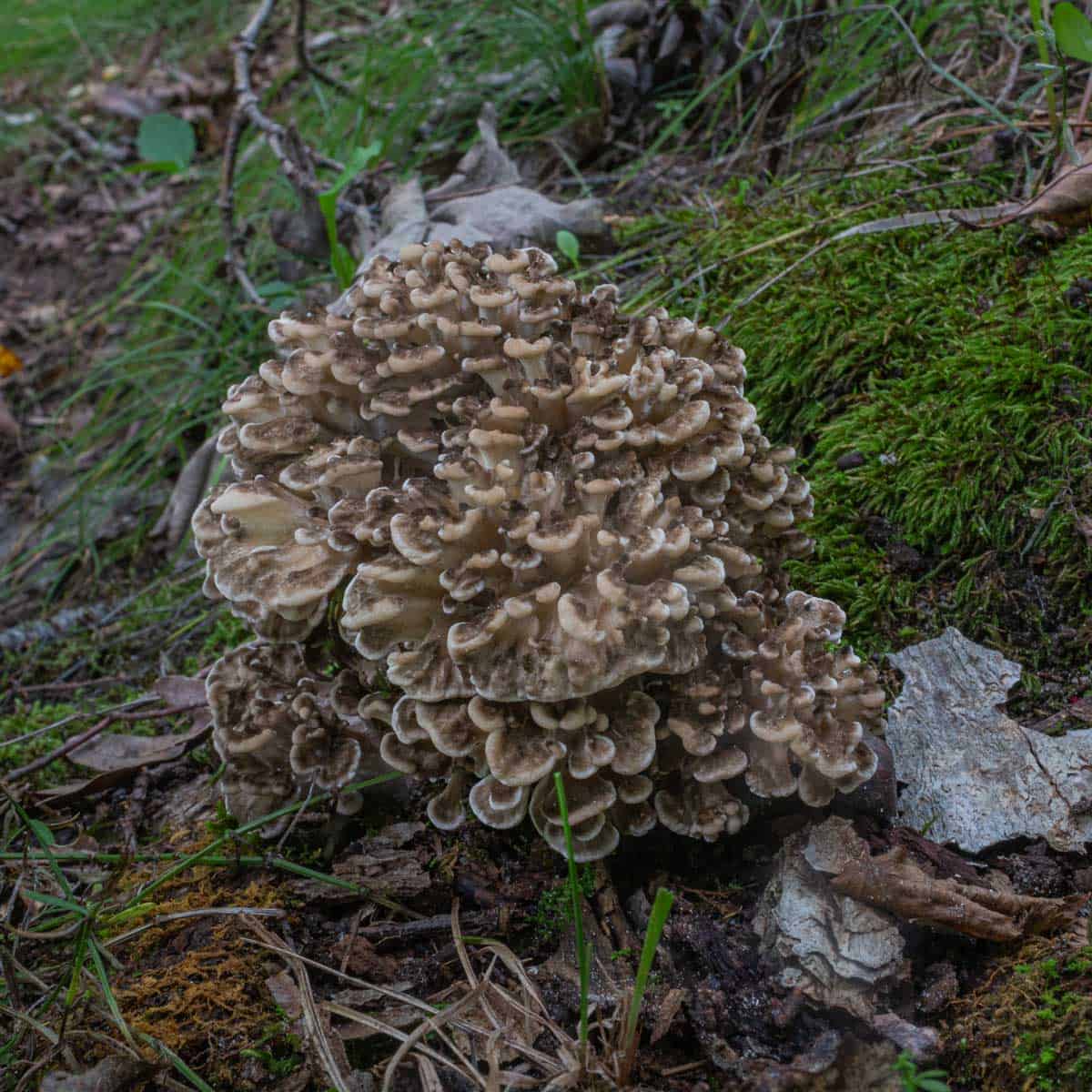
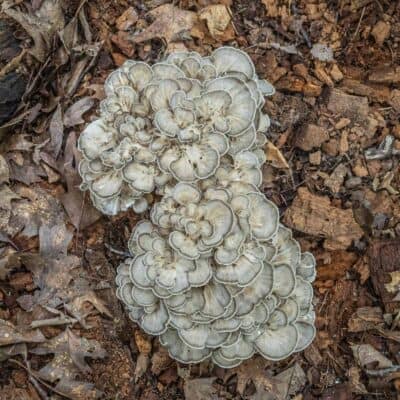
Hens are tricky enough to clean as it is, but if it rains, dirt will splash on the mushroom and dry, and the mushroom will physically absorb the dirt into its flesh as it grows.
How to Clean Hen of the Wood
These can be easy to clean, or very difficult depending on the growing conditions. First, you separate the mushroom into large leaves or clusters and inspect for twigs and debris. The flesh should be pure white-cut away dirty or discolored portions.
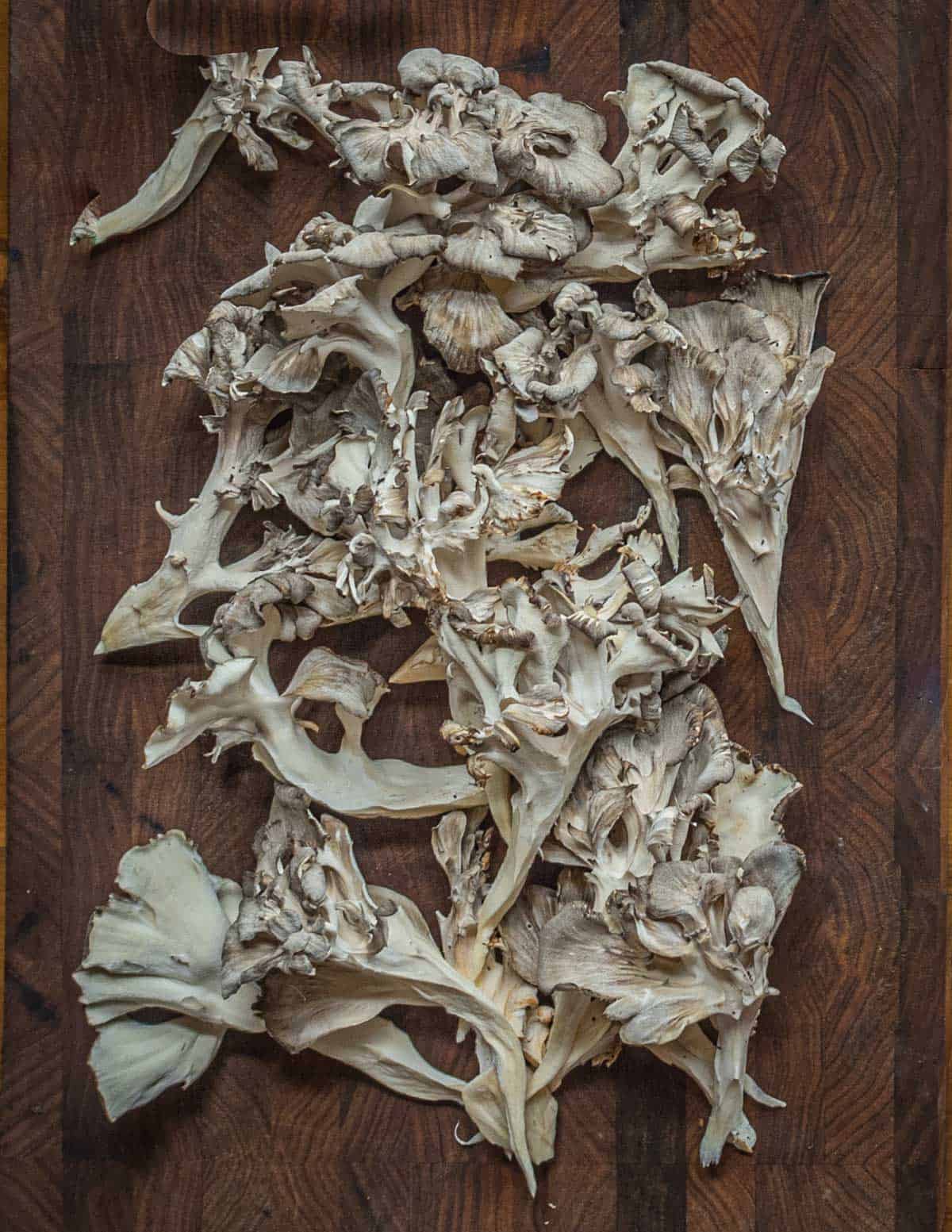
As the mushrooms age they turn a shade of dingy yellow-beige. Very clean mushrooms can be cut in thick slices, but finding them in a perfect stage can be tricky. Sometimes, especially after rain, the mushrooms can absorb dirt into their flesh making them impossible to clean. Larger, older mushrooms are usually more difficult to clean than young ones.
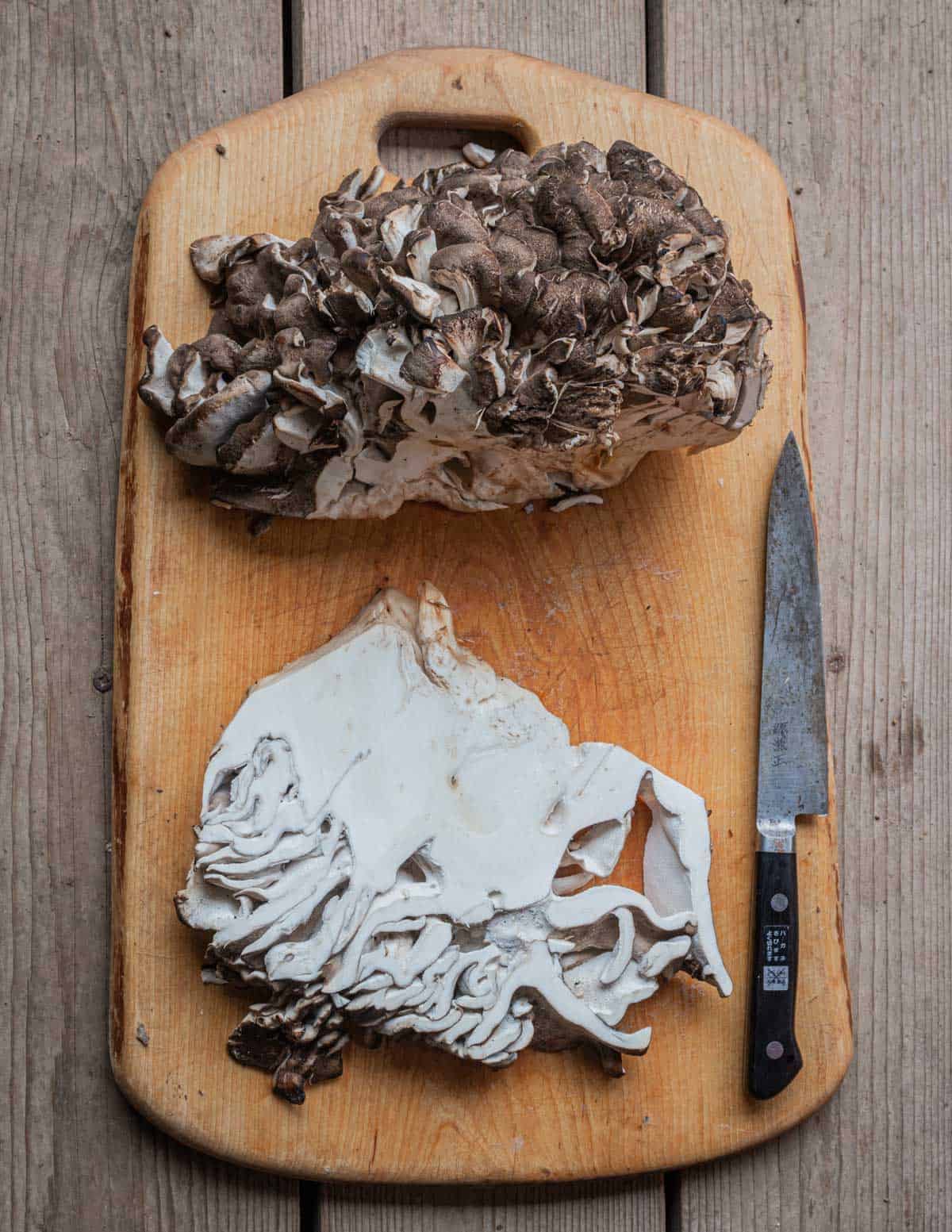
This might only be an acorn or a twig to remove, but debris is often lodged inside the mushroom flesh itself, as the mushrooms will absorb dirt that falls on them as they grow. One time a diner at a restaurant broke his tooth on a pebble in the mushroom itself.
The mushrooms are usually free of larvae but are often home to insects like pill bugs, centipedes, ants and spiders. I once found one with a baby snake inside. It's all part of Nature's design as the mushrooms function as shelter for small creatures. They're literally a bug hotel.
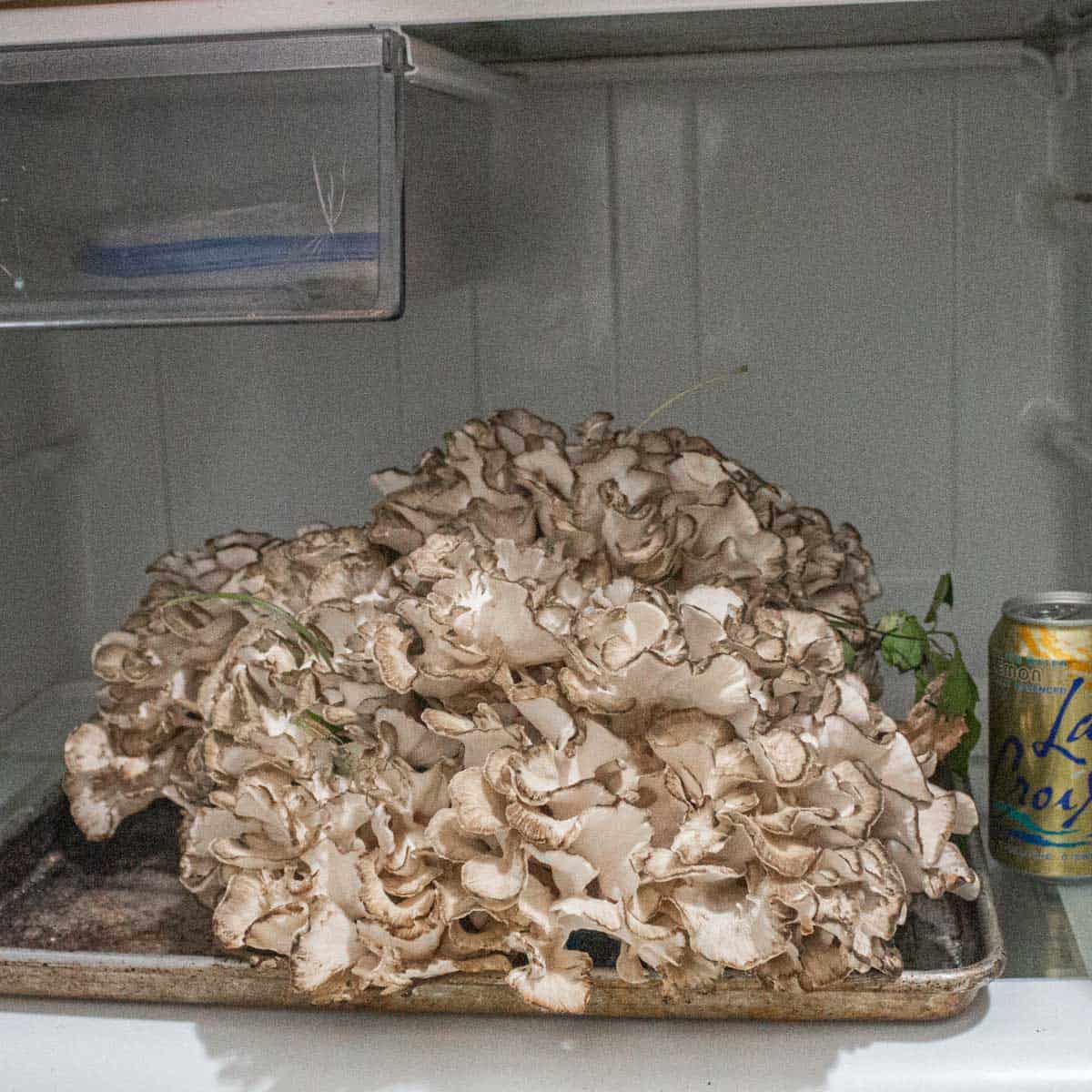
Once the mushrooms are cut, you can swish them in a sink of cold water, dry them on paper towels, and store the hen of the woods in a Zip Loc bag with a dry paper towel in the fridge. If you don't have time to clean them, store them whole in the fridge and clean them as soon as possible. Properly stored, the mushrooms will last for at least a week or more.
How to Cook Hen of The Woods
Hen of the woods taste meaty and delicious with a mild mushroom flavor. You can substitute them in just about any mushroom recipe, but keep in mind cultivated mushrooms grown on a substrate don't taste as good as wild ones. To cook, Just separate the mushrooms into bite size clusters and fry, sauté, stew, braise or roast them.
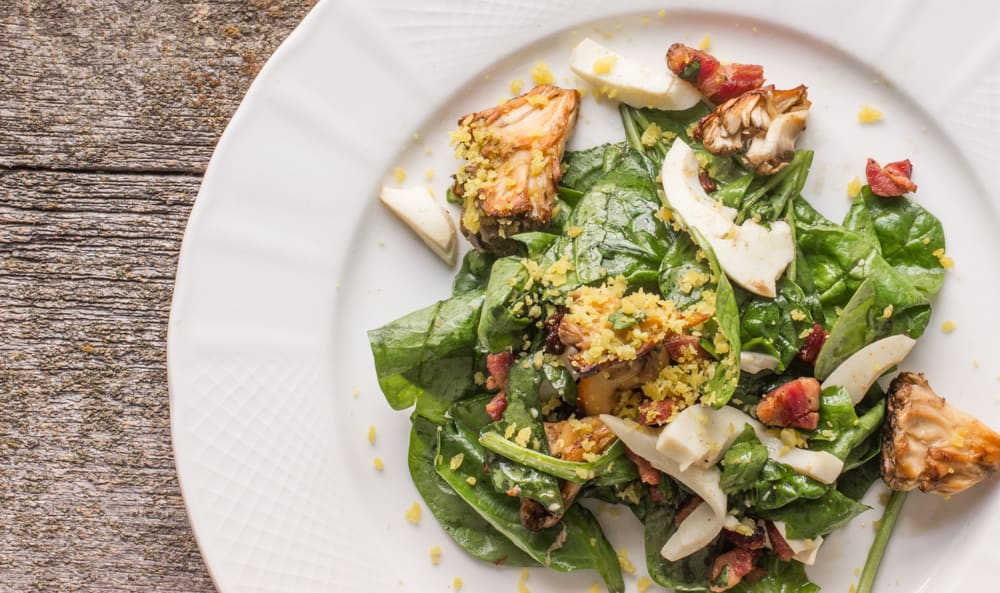
Their size also makes them a great mushroom meat substitute for vegan and vegetarian mushroom recipes like my Wild Mushroom Taco Meat.
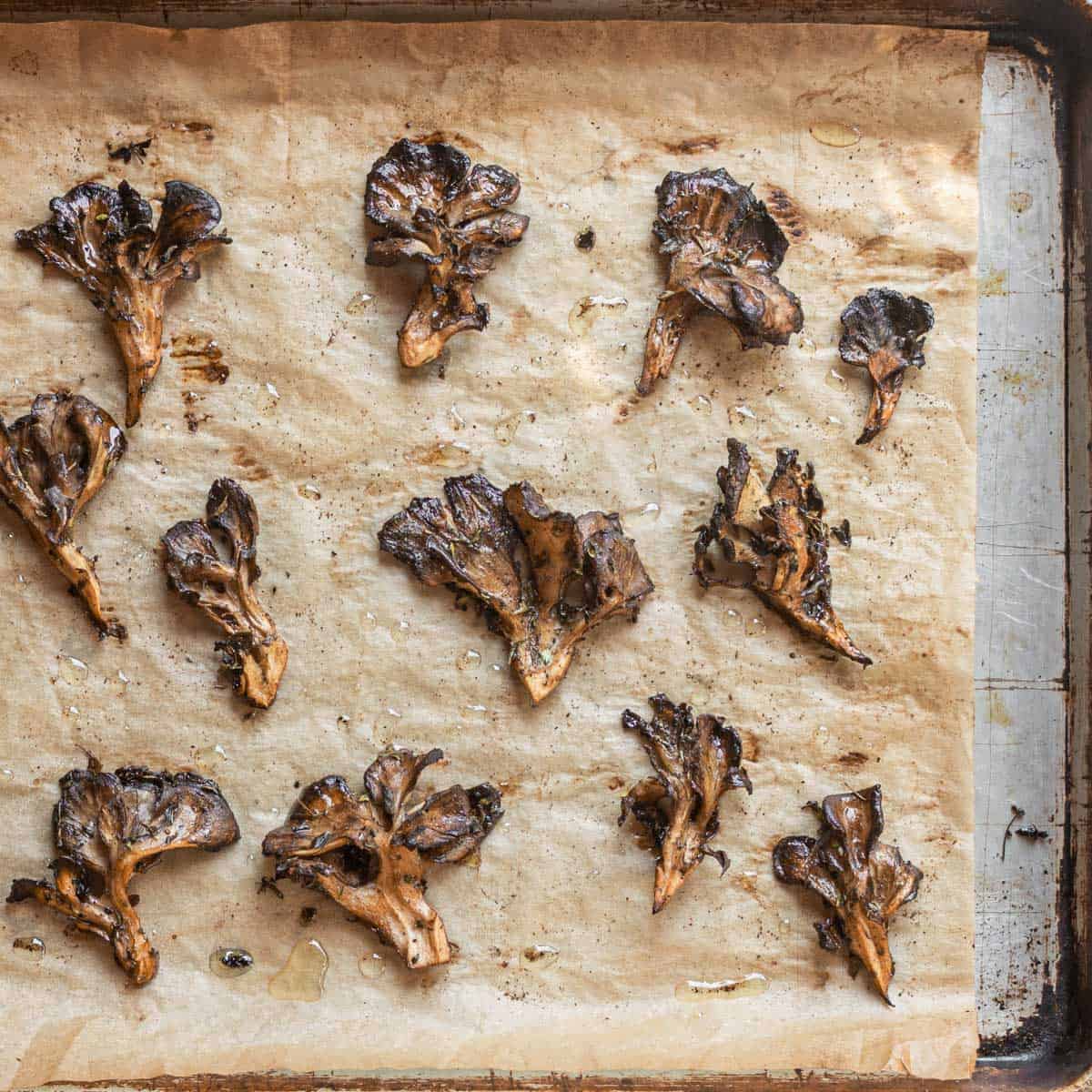
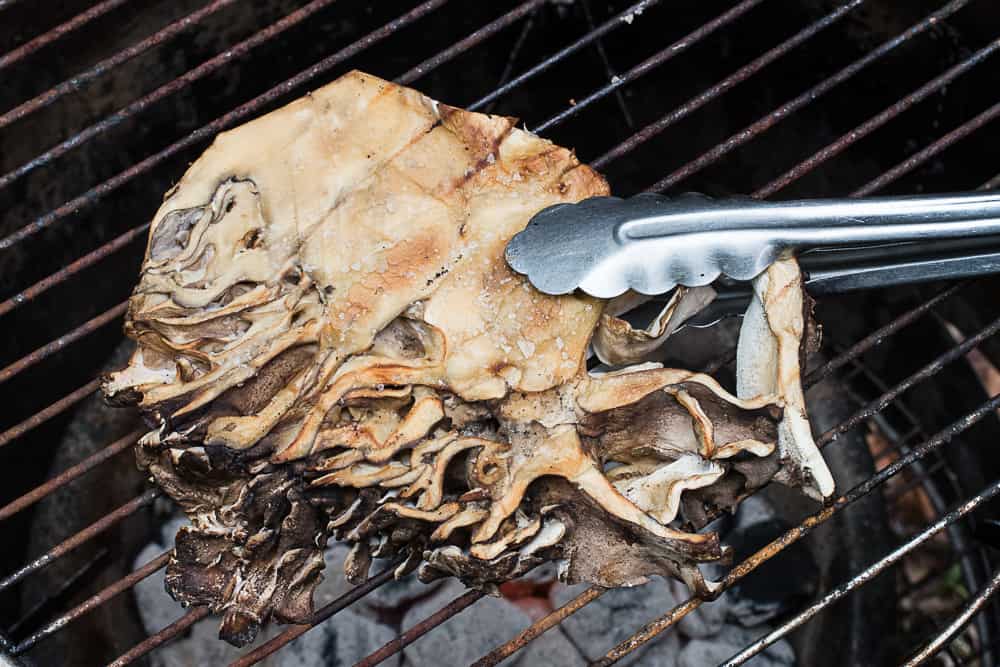
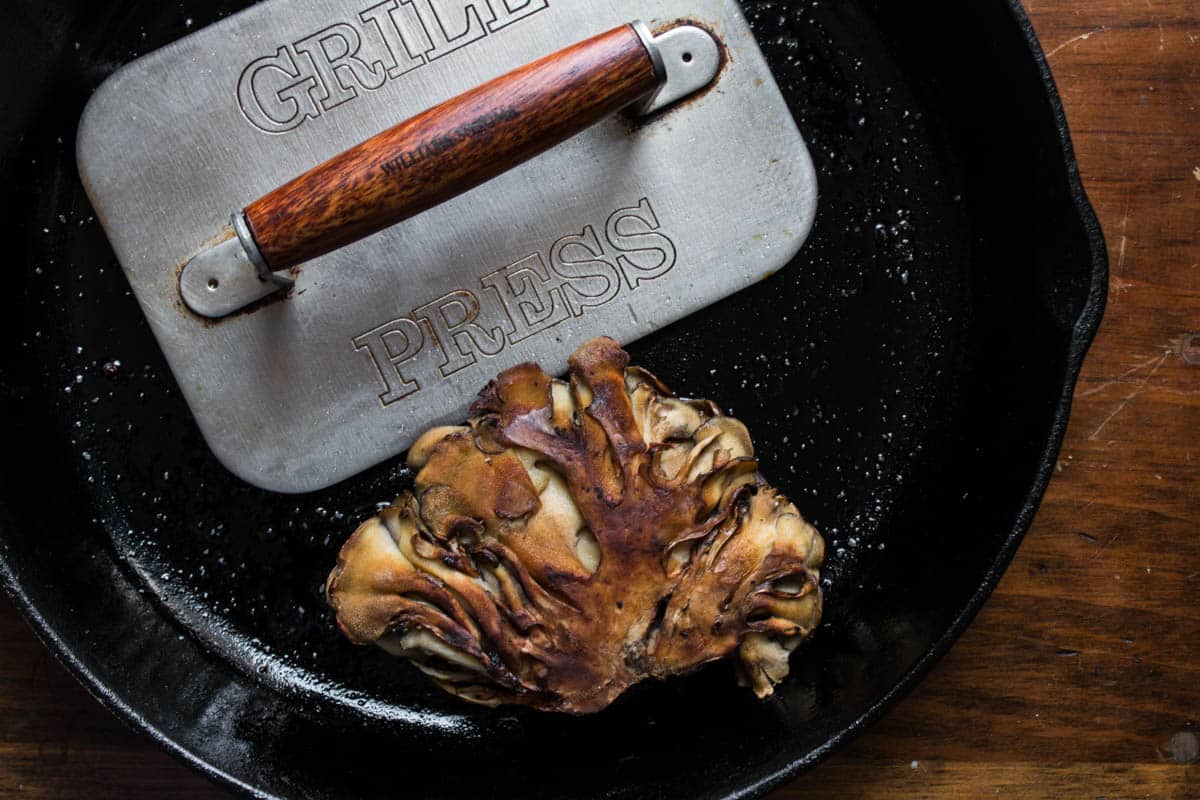
If you find a perfectly clean mushroom, a favorite hen of the woods recipe is roasted whole or cut into thick slices and grilled as hen of the woods steaks. You'll need young, very clean mushrooms to make steaks but when you find a good one, it can be an easy way to make a great meal.
To preserve them, the mushrooms can be, pickled, frozen, dried and/or powdered to use in seasoning blends for soups and sauces. Freeze drying works well too. Hen of the woods mushroom jerky is a crowd favorite too. Dried mushrooms become very tough, and are best used for stock where the mushrooms are discarded afterward.
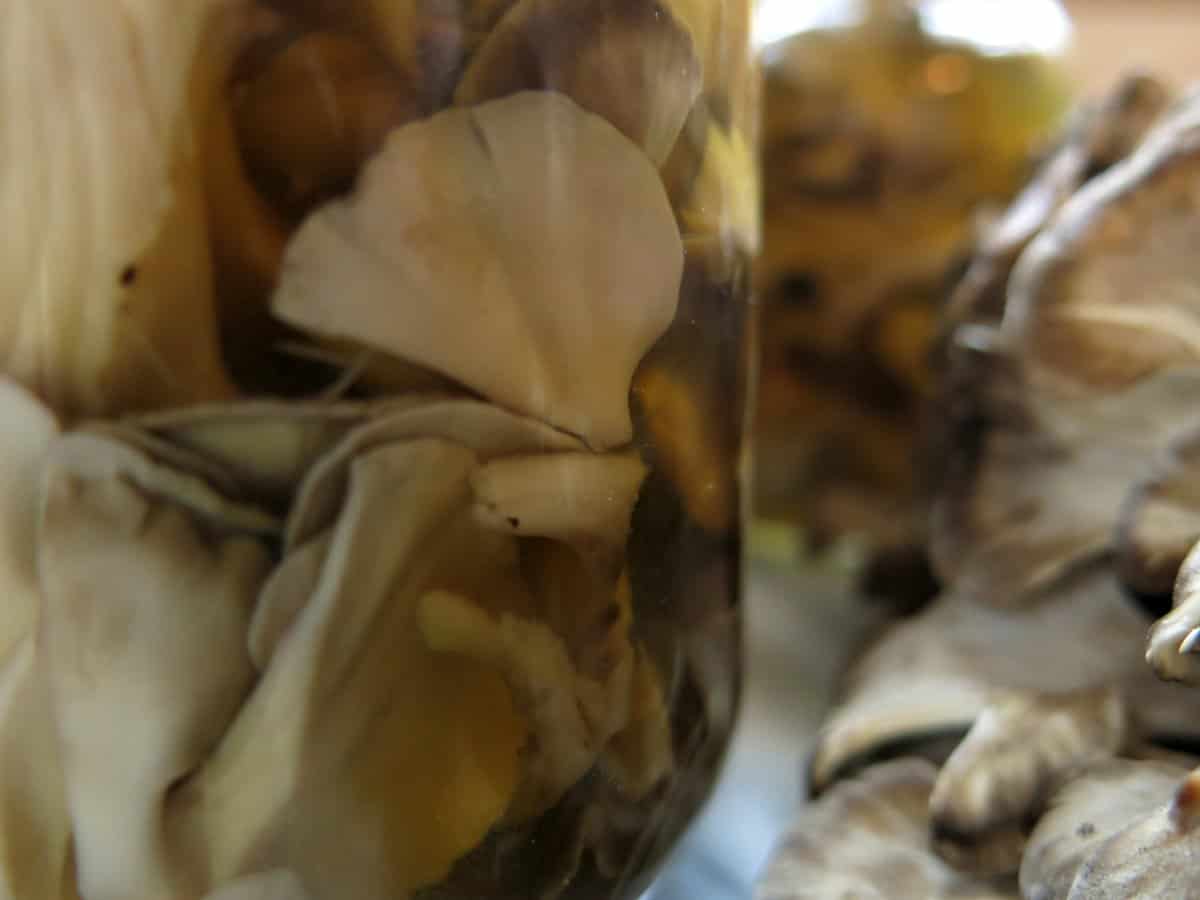
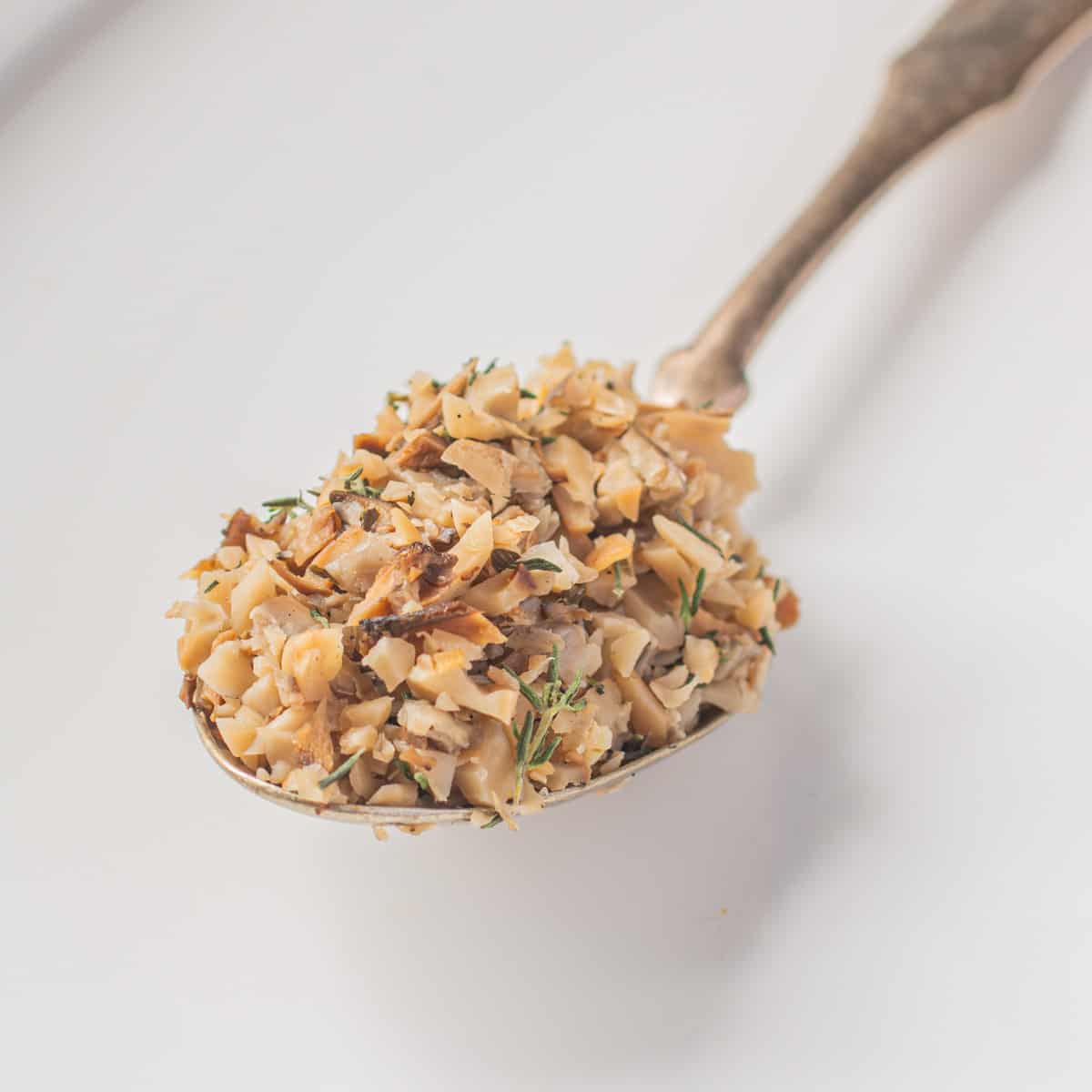
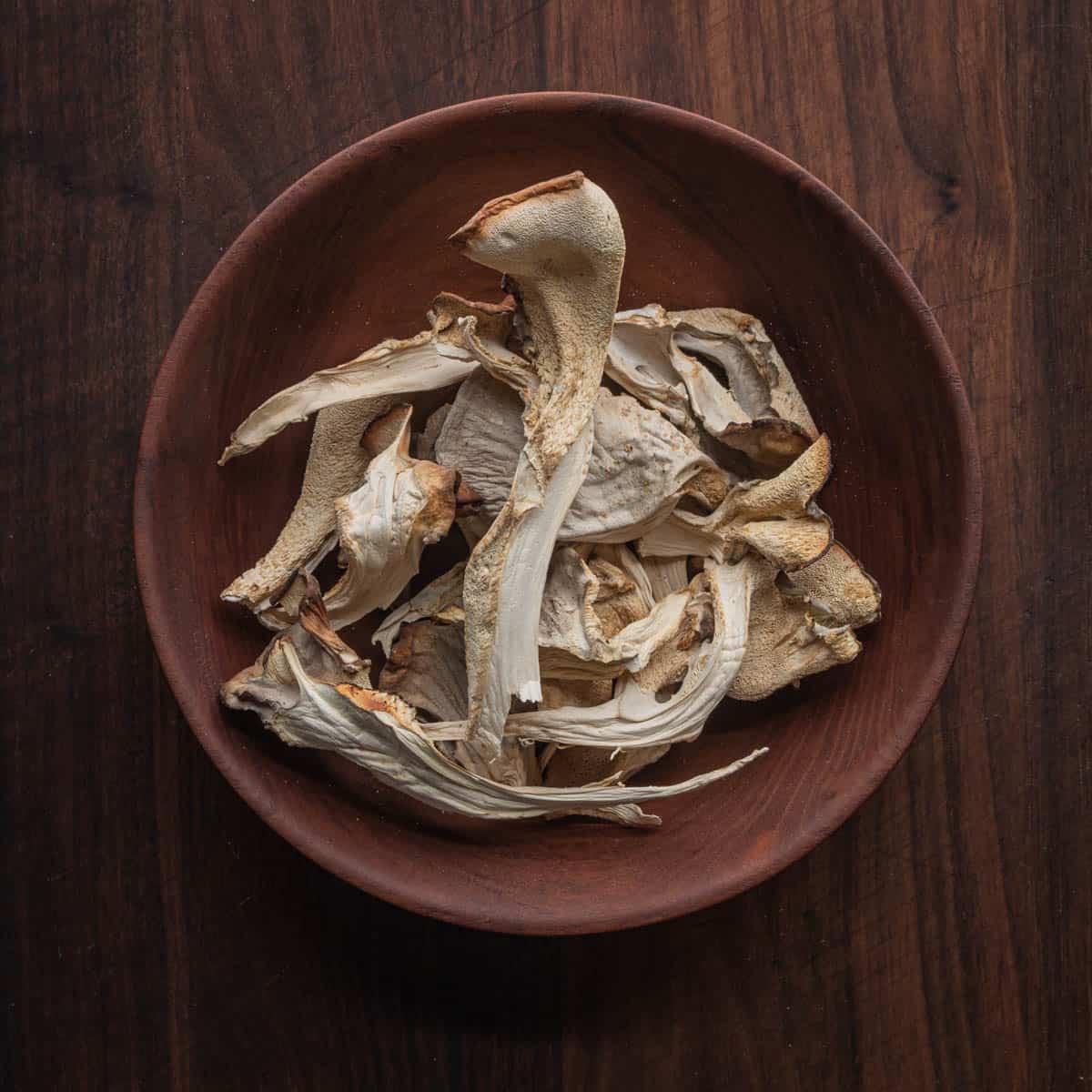
Freezing is a one of the best options to preserve these mushrooms and, unlike others, hen of the woods can be frozen raw or cooked. I usually cook my mushrooms before I freeze them. I make wild mushroom duxelles to use in stuffings, or cook and vacuum seal them as in my post on freezing wild mushrooms.
The IQF (individually quick-frozen) technique works well for freezing. To do it, take or a whole chunk or pieces of clean mushroom and put them on a cookie sheet lined with parchment. Freeze the hen mushrooms, place in a bag and vacuum seal. Cook the mushrooms straight from frozen.
Hen of the Woods Recipes
Recipes I've made specifically for maitake or where they would be good substitutes.
- Brown Butter-Sage Hen of the Woods
- Simple Roasted Hen of the Woods
- Pickled Hen of The Woods
- Mushroom Conserve
- Roasted Maitake Mushrooms with Anchovy Sauce
More Hen of the Woods Mushroom Recipes
FAQ
Put the cleaned mushrooms into a Zip Loc Bag with a paper towel. Open the bag occasionally to let them breathe. Cultivated mushrooms will last 3-4 days. Wild mushrooms will last a week or even longer.
Asian grocers usually carry the Hotko Brand maitake, a 3.5 oz package costs around 3.99. Wild maitake can be bought at farmers markets during the season for $10-25 / lb.
Yes, but they're slightly bitter. The fact that they taste so good cooked makes eating them raw unnecessary.
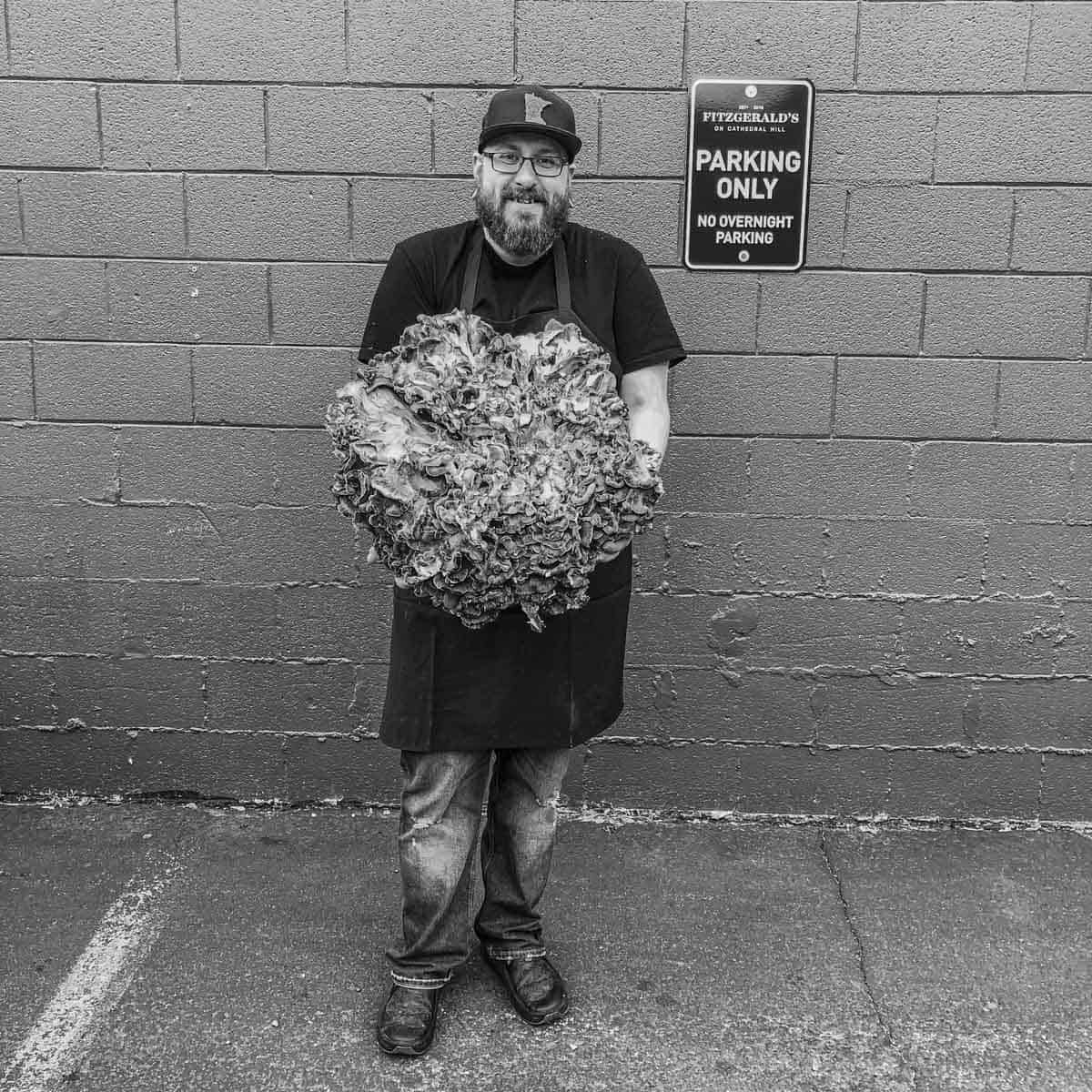

Gina
I absolutely admire you! I recommend your site to everyone! I live on Beaver Island in the upper part of Lake Michigan. I welcome you anytime! The island is chuck full of mushrooms! Just brought home a Maitake and plan on making jerky.
Alan Bergo
Thanks Gina.
Walter Cook
I have been eating what everyone told me was a Hen-of-the-Woods, but after looking at your pictures and reading the descriptions, I am pretty sure it is a Berkley's polypore. Not much to eat as, like you said, only the edges are tender. Sad because these things are HUGE.
Could you use the tougher parts for flavor in stock? And...How would you you do that? Thanks...Walter
Alan Bergo
Hi Walter. The first suggestion I have would be using my recipe for black staining polypore broth.
Judi Lifshutz
I found this large mushroom in a raised bed in the circle of my driveway. There is an old stump, but not exactly close to the mushroom. The mushroom is actually nestled next to one of my rose bushes, near my mint, and under a number of common milkweed plants. I'm in and about the milkweed plants daily, and didn't notice the mushroom until it was very large - larger than a dinner plate. Would this be a hen of the woods? Wish I could attach a picture.
Thanks!
Alan Bergo
Post a picture in a faceboook group in your area for mushrooms, or a mushroom ID group on FB. Or, you can send a pic to my email.
Brenda Moore
I have what I think is hen of the woods growing in the mulch in my yard. You did not mention them growing in mulch in the article though. There is a Japanese Maple tree about 20 feet from them, but no other trees any closer. This is the first time I've seen them although we've been mulching that part of the yard for 20+ years. Could they be growing from whatever kind of tree the mulch was made from?
Alan Bergo
Without pictures it’s hard for me to speculate. I don’t mention them growing from mulch because they don’t. They do grow with maple occasionally, if what you have is a hen, which I doubt. Much more likely a black staining polypore or Berkeley’s polypore. It’s very early for hens.
Janet Wong
Thank you for this fabulous post, Alan! You mentioned that you know of a grower who uses a more natural substrate; do you feel comfortable mentioning the name (or giving a few names of companies that we can order from when we can't get wild hens)?
Alan Bergo
It was D'Artagnon, I don't know if they're still selling them. I sometimes buy cultivated hens from Asian markets-they're not the same as wild, but they're also easier to clean.
Janet Wong
Thanks so much for the info, Alan!
Mary ferguson
I’m interested in mushrooms and how beneficial they are to health wise ,and can a person grow these or I’m just very curious of how pickle and grill plz help
Alan Bergo
Sorry Mary, I don't discuss medicinal aspects on this site as I'm not an expert at that.
Ruby
Thank you for your post. I recently found a large hen of the woods (I think) mushroom in my yard. I am new to foraging, so I still have not harvested it. How do you know when a mushroom is "old"?
Alan Bergo
Hens are too old when they are buggy past your comfort level, woody and tough, and likely spored out. That being said, the spored out part is more flexible for me, and I regularly find some that are fine to eat that have started to spore. If I look in them and they seem very dirty, full of worm holes and excrement, I will pass. Over time once you handle some of differing ages this will make sense.
Alan Bergo
So that can come down to personal preference a bit. If it is very bug eaten, wormy, or just dried out and not tender, I will pass. With other mushrooms, going to spore can mean they're past prime, but hens can stay tender for a decent amount of time, and I have some friends who will eat hens on deaths door. The age will make more sense once you've harvested a few of them of slightly different ages.
Jackie
Found an orange hen today on the Finger Lakes Trail.
Alan Bergo
Hens aren't orange. Poisonous Omphalotus is though.
Laura
I have Maitake growing in my yard. I have had three harvests! The first a mushroom thief helped themselves to( people have helped themselves to our mushrooms for 20 years) I finally put up a little garden fence with a Don't pick the mushroom sign to keep them away. I have picked 40 plus pounds., I sold 20 pounds to a forager and kept the rest. I want to make soup.with a lot of it,. So would it be good to use a lot of the stalk in the soup? Does the stalk have the same flavor as the ends??
Patrick J Gambino
I have been picking Hen of the Woods for 20 year, and some year are better than others. Does it have anthing to do with the amont of rain we get that year? I live in Western New York, and I have a spot with very old oaks. They call them witness trees because they witnesed the war of 1812. Last year the one woods I hunt I found at lest 10 this year not one yet. It seems like they all come up around the last week in September or first week in October.
Jared
Hello,
First, I’ve thoroughly enjoyed your website as a great resource for mushroom foraging! Thanks for providing it!
Second, I located a beautiful maitake specimen growing from the base of a tree in my neighbor’s yard, right at the intersection of where their driveway and sidewalk connect. My neighborhood’s street sees low to moderate numbers of vehicles moving along the street each day...my neighbor granted me permission to harvest the cluster, but I’m wondering if I should leave it be knowing that many mushroom species are able to absorb heavy metals, etc from vehicle exhaust emissions, among other pollutants in the environment? What do you think? Thanks.
Alan Bergo
It should be fine.
Oliver
Awesome article on the Hen of the Woods mushroom!
Next time I go out to the woods near my house I will check for some fallen oaks, stumps, and dead matter and see if I find any hens.
For cooking them though do you recommend to grill or saute them to make them more meaty tasting?
Thanks.
Alan Bergo
Grilling or pan roasting are my favorite. See my post on hen of the woods steaks.
Ricky
I picked a nice size Hen of Woods in NY (5-6 lbs). When I got home hundreds/thousand of tiny white bugs or eggs started falling/jumping out. I took the whole thing and put in out on my deck table. Is there a way to get rid of the bugs/larva and are they poisonous or edible. I am ready to trash the whole thing.
Interesting because we found a few others on surrounding trees and they are totally clean.
Please let me know.
Thanks
Alan Bergo
Hi. I'm assuming that the little bugs you're talking about looked like maggots? Small, white, wiggling around, etc? Mushrooms in our region (I'm in MN and we share some similar habitat) will often have bugs like that. As you discovered, some may have a large amount, and some may have none. Over time, you'll learn how to inspect mushrooms, especially large polypores like chicken of the woods for these before bringing them home, since when their house (the mushroom) is agitated, they will ahem "migrate" out, onto and into whatever they can. It can be a little unnerving, but like everything else in nature, they have a purpose, although yes, they are disgusting. Even so, finding maggots in hen of the woods is very, very rare for me, more often I just have to give it a good shake and inspect for centipedes, spiders and the like, which are no big deal. With chicken of the woods it's much more common. If I were you I would trash the big one since you have smaller, untouched mushrooms to cook. Know too, that if you leave uninfested mushrooms near one with a bug population, all will become infected.
Mark Pettigrew
I'm very fortunate to live in eastern Illinois. We have a vast variety of fall mushrooms. Hens, oyster, honeyring, lacaria, meadow, both types of chicken of the woods, lions mane and a number of bolette types. I have harvested all but the lions mane this year. My personal best hen is 57lbs. I love love love finding them.
Alan Bergo
Yes, hens can get absolutely massive.
Jacqui
I just "scored" several kgs of Meripilus giganteus, the European Black Staining Polypore. When I say "scored" I found it and took a piece home to ID. When I got home I noticed the black staining, which made the IDing so much faster. Then I cooked up a bit and ate some and am waiting to see that I suffer no immediate problems myself before I feed it to my family. The flavour is mild mushroomy - no acidity of a beefsteak mushroom or lemony undertones of a chicken of the woods - and the texture is very good. It's firm and not very fibrous, making me wonder about the negative comments I have read about these mushrooms from multiple sources.
Alan, have you ever eaten this mushroom? Do you know anything about it? I am particularly interested in it because my son, who is becoming a vegetarian with the exception of scavenged meat (and possibly the mice that I trapped in the cellar - I think he counts that as scavenged) wants to make Thai curry with my frozen chicken of the woods, and I think these are too precious to be smothered in spicy curry and coconut milk... but the Meripilus giganteus has the right texture to be a chicken substitute in a curry and is pretty neutral, so it would be no loss. Also, I just found kgs and kgs of it...
Any thoughts on this or has it not yet crossed your path?
Alan Bergo
Oooooh. Jacqui this is one I haven't had the chance to try yet. Bonderzewia Meripilus type polypores are pretty rare where I live. Hens however, are very abundant. given the choice between all of them, I'll gladly take the hens (no complaining here) but I've always wanted to try the black stainer. Curry with either chickens or meripilus sound great, and I regulalry make chicken curry when we get large flushes. I started passing the chickens up this year as there have been so, so many of them. Good luck, and let me know how you like them, I'm a little jealous 😉
jacqui
I wonder if I could mail you some... It's fairly dry ... could work.
Regina
I got two medium clumps of freshly picked hen of the woods two weeks ago. i have them on the bottom shelf of my fridge in an open box. I totally forgot about them. i never cleaned them. they are now dry. are they still good?
Hannah Smith
We have one of these growing right in our front yard, where our old swamp oak used to be. It's not a terribly large one, but still...free mushrooms for a couple months at least.
Hen Woods
The best producing hen of the woods tree in maine is located at the Spirit Pond Preserve Phippsburg land trust trails in Phippsburg maine.
the coordinates are approximately: 43.751511, -69.807439
Spirit Pond Hen Of The Woods Red Oak Tree Map Link:
https://goo.gl/maps/xav2jNiw9u82
every single year this ancient red oak produces at least 50 pounds of prime grade A hen of the woods, maitake, grifola frondosa, g. frondosa mushrooms! Hen of the woods seems to be independent of drought conditions. Though after years of hen hunting, I have only found hen-of-the-woods mushrooms within 200 feet of water, whether that be salt water or fresh water, or brackish water. Often times the old oaks where they are found are immediately on the edge (even overhanging) of a body of water, and frequently near tidal areas along the coast of maine.
The Spirit Pond oak tree produces from the middle of September to the middle of October every single year, and has done so for at least the last 15 years and probably longer. The tree is located toward the beginning of the spirit pond trail and about 200 feet from spirit pond at the site of an old homestead and near the spirit pond burial ground. the tree fell directly over a portion of the trail in 2015 but still grows hen of the woods mushroom from the remaining stump, around the stump and from the base of the fallen tree itself in huge numbers and size. Check this tree frequently during the season as it is well known locally to grow hens.
Where to find the second most productive hen of the woods oak tree in maine is at the Center Pond Phippsburg land trust trail in Phippsburg maine. It is located at the edge of center pond just opposite the beaver pond along the main trail.
Center Pond Phippsburg Maine Hen of the Woods Map Link
https://goo.gl/maps/6RM8cur8mio
43.809922, -69.815736
The preceding geo-location in this instance is exact. The fallen trunk of this tree can be seen on google maps satellite view. This grifola frondosa supporting red oak tree has grown mushrooms as late as mid November and particularly on, and inside the hollow portion of the fallen tip-over dead section which actually rests in Center Pond itself.
The hen of the woods that this tree produces range from 10 - 20 pounds. this tree is easily accessed and well known, so the maitake go quickly. if you're the lucky one to get a 15 pound hen of the woods from this tree, you'll understand why it's called the dancing mushroom.
Nick L
What are your thoughts on boiling these for 20-30 min in pieces and freezing in the remaining water/juice?
Alan Bergo
Sure you can do that, typically I make duxelles to save space.
Luigi Moscardino
I have been picking hen of the woods for 50 years. I live on long island, N.Y. These mushrooms come out every year on the same trees. If you dont find them on the first full moon in September, then you will find them on the October full moon.
Mary
How can I do this picking a hen
A
I like your site and videos. Lots of good stuff. I didn't realize these mushrooms grow in people's yards. However, I don't recommend hunting for mushrooms while driving, pretty dangerous.
Alan Bergo
Mushroom hunting by car is great fun. The key is not to do it on the freeway. Think slow drives on country roads.
Dennis
"Their are no poisonous look"
should be "There are..."
Joe Wiercinski
I'll be trying your recipes with the 10-pounder I found 10-28-16 in Mercer County, Pennsylvania. Cheers. Joe Wiercinski
Alan Bergo
Good for you! Happy hunting.
Rhonda
Can you tell me what this mushroom is. I was told hen of the woods but it is not grayish its more yellowish brown is.
Alan Bergo
You can post in a Facebook mushroom group or send me a picture via email.